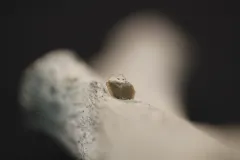What the Megalodon Left Behind

The largest shark ever to exist on this planet, Carcharocles megalodon, could grow to be 60 feet (18 meters) in length and weigh over 120,000 pounds (60 tons). Five rows of fearsome teeth—some over 7 inches long—gave rise to the name Megalodon, meaning “big tooth.” This massive animal, whose jaws were large enough to eat a modern-day adult rhino, most likely preyed on whales.
What were whales to do in the face of such a gigantic predator?
Meghan Balk, a Peter Buck Fellow at the Smithsonian’s National Museum of Natural History, wants to test the hypothesis that small-bodied prey species evolve larger body sizes to escape predation. The larger the prey animal, the more energy it takes for the predator to attack and the risk of being injured itself becomes greater. Since the smaller prey animals were eaten by far bigger predators, prey lineages may have evolved to become larger. For Balk and her summer intern, Jazmin Jones, studying Megalodon and its prey is ideal for testing this hypothesis since the giant shark went extinct about 2.6 million years ago and scientists think it was probably due to a lack of available prey. If the prey species the shark was accustomed to eating got bigger—too big to attack even—that could explain the shark’s demise.
Before one can look at prey sizes over time, you first have to know what the prey species are. This summer, Jones was tasked with examining marine vertebrate fossils in the NMNH collection to identify who was being bitten. Megalodon first patrolled the water during the middle Miocene, around 14 million years ago, but was extinct by the end of the Pliocene, which ended about 2.6 million years ago. So, Jones photographed and documented all the marine fossil bones from the Miocene and the Pliocene geological epochs for evidence of shark bites.
For three weeks, Jones inspected bones—around 100 in total—to look for marks and then cataloged the marks according to a classification system of six groups. The marks ranged from a fully embedded tooth to a subtle scratch mark. The embedded teeth were particularly exciting as Jones only found about four throughout the course of the three weeks, but even without such a find the process was fun. “It’s very exciting because each bone is unique,” said Jones. “It has its own unique set of scratches and patterns. Sometimes I come across strange things…it’s like solving a mystery because I can infer and possibly create a story to explain some marks.”
It can be quite difficult to determine the predator without the help of an embedded tooth—serrated marks may indicate a Megalodon bite since the colossal shark had ridges in its teeth. It is also difficult to identify the species associated with the bone, especially when only a fragment of bone remains. But even placing a bone into a particular group (such as the Mysticetes, the baleen whales, and Odontocetes, toothed whales) can be helpful. Both Mysticetes and Odotocetes were present during the Miocene and Pliocene and were likely preyed upon by Megalodon. Jones recorded every bit of information, from the bone size to descriptions of the various marks, in order to hopefully make a positive future ID of both predator and prey species.
At the end of Jones’ three weeks, there was a small dent in the task of cataloging the almost 4,000 NMNH marine bones from the time when Megalodon roamed the oceans. Once the prey species are known, the work of estimating body mass of the potential prey can begin. It will take time to definitively answer the question of whether Megalodon’s prey evolved to get bigger to avoid predation by way of the shark’s jaws. A close look at each bone can help put together pieces to tell a story, and eventually show the full picture of past predation.


